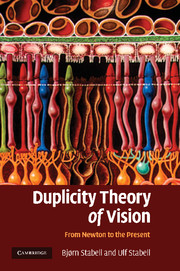Book contents
- Frontmatter
- Contents
- Acknowledgements
- 1 Introduction
- Part I The development of the basic ideas of the duplicity theory from Newton to G. E. Müller
- Part II The development of the duplicity theory from 1930–1966
- Part III Chromatic rod vision: a historical account
- Part IV Theories of sensitivity regulation of the rod and cone systems: a historical account
- Part V Factors that triggered the paradigm shifts in the development of the duplicity theory
- 28 Summary of K.R. Popper's and T.S. Kuhn's models of scientific development
- 29 The development of the duplicity theory as a test of Popper's and Kuhn's models
- References
- Index
28 - Summary of K.R. Popper's and T.S. Kuhn's models of scientific development
Published online by Cambridge University Press: 22 January 2010
- Frontmatter
- Contents
- Acknowledgements
- 1 Introduction
- Part I The development of the basic ideas of the duplicity theory from Newton to G. E. Müller
- Part II The development of the duplicity theory from 1930–1966
- Part III Chromatic rod vision: a historical account
- Part IV Theories of sensitivity regulation of the rod and cone systems: a historical account
- Part V Factors that triggered the paradigm shifts in the development of the duplicity theory
- 28 Summary of K.R. Popper's and T.S. Kuhn's models of scientific development
- 29 The development of the duplicity theory as a test of Popper's and Kuhn's models
- References
- Index
Summary
Although scientific theories and laws of nature may never be proved in any definite way by induction, as Hume had made clear, Popper (1969, 1975, 1994) pointed out that they may be falsified on the basis of empirical evidence and purely deductive reasoning, i.e. the modus tollens deduction form of classical logic (see Popper, 1975, pp. 75–77). Hence, he assumed that scientific theories could be tested by attempts to refute them, and by selecting the most successful theories that withstood severe falsification tests, Popper believed that science could progress ever closer to, but never reach, the ultimate truth. The key to scientific development, therefore, according to Popper, was not the collection of observational statements, but the emergence of competing, falsifiable theories. Only by searching for falsification of theories and, on this basis, selecting the most successful ones, could science hope to learn and advance.
Popper's view of scientific progress may be summarized as follows: progress starts when a theory is refuted or falsified. This will create a problem for the relevant scientific community. In order to solve the problem other falsifiable theories are proposed. These new theories are then criticized and tested. As a result one or a few of the theories will prove more successful than the others, i.e. they may withstand severe falsification tests, may have greater empirical information or content, may be logically consistent, may have greater explanatory and predictive power, and may be more simple. Eventually, however, even the most successful theory will be falsified.
- Type
- Chapter
- Information
- Duplicity Theory of VisionFrom Newton to the Present, pp. 199 - 202Publisher: Cambridge University PressPrint publication year: 2009



